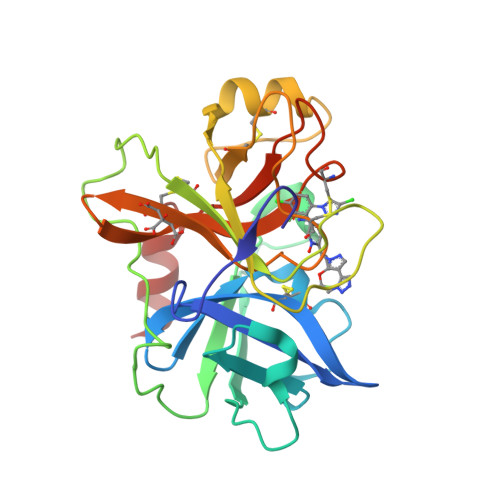GtoPdb is requesting financial support from commercial users. Please see our sustainability page for more information.
coagulation factor XI
Target not currently curated in GtoImmuPdb
Target id: 2360
Nomenclature: coagulation factor XI
Contents:
Gene and Protein Information  |
||||||
| Species | TM | AA | Chromosomal Location | Gene Symbol | Gene Name | Reference |
| Human | - | 625 | 4q35.2 | F11 | coagulation factor XI | |
| Mouse | - | 624 | 8 25.14 cM | F11 | coagulation factor XI | |
| Rat | - | 556 | 16q11 | F11 | coagulation factor XI | |
Previous and Unofficial Names  |
| Cf11 | FXI | plasma thromboplastin antecedent | PTA |
Database Links  |
|
| Specialist databases | |
| MEROPS | S01.213 (Hs) |
| Other databases | |
| Alphafold | P03951 (Hs), Q91Y47 (Mm) |
| BRENDA | 3.4.21.27 |
| ChEMBL Target | CHEMBL2820 (Hs) |
| DrugBank Target | P03951 (Hs) |
| Ensembl Gene | ENSG00000088926 (Hs), ENSMUSG00000031645 (Mm), ENSRNOG00000013684 (Rn) |
| Entrez Gene | 2160 (Hs), 109821 (Mm), 290757 (Rn) |
| Human Protein Atlas | ENSG00000088926 (Hs) |
| KEGG Enzyme | 3.4.21.27 |
| KEGG Gene | hsa:2160 (Hs), mmu:109821 (Mm), rno:290757 (Rn) |
| OMIM | 264900 (Hs) |
| Orphanet | ORPHA121660 (Hs) |
| Pharos | P03951 (Hs) |
| RefSeq Nucleotide | NM_000128 (Hs), NM_028066 (Mm), NM_001047848 (Rn) |
| RefSeq Protein | NP_000119 (Hs), NP_082342 (Mm), NP_001041313 (Rn) |
| UniProtKB | P03951 (Hs), Q91Y47 (Mm) |
| Wikipedia | F11 (Hs) |
Selected 3D Structures  |
|||||||||||||

|
|
||||||||||||
Enzyme Reaction  |
||||
|
||||
Download all structure-activity data for this target as a CSV file 
| Inhibitors | |||||||||||||||||||||||||||||||||||||||||||||||||||||||||||||||||||||||||||||||||||||||||||||||||||||||||||||||||||||||||||||||||||||||||||||||||||
| Key to terms and symbols | View all chemical structures | Click column headers to sort | |||||||||||||||||||||||||||||||||||||||||||||||||||||||||||||||||||||||||||||||||||||||||||||||||||||||||||||||||||||||||||||||||||||||||||||||||
|
|||||||||||||||||||||||||||||||||||||||||||||||||||||||||||||||||||||||||||||||||||||||||||||||||||||||||||||||||||||||||||||||||||||||||||||||||||
| Inhibitor Comments | |||||||||||||||||||||||||||||||||||||||||||||||||||||||||||||||||||||||||||||||||||||||||||||||||||||||||||||||||||||||||||||||||||||||||||||||||||
| BMS-962212 is a small molecule FXIa inhibitor - Ki 0.7 nM [6]. Asundexian (BAY 2433334) inhibits FXIa activity in vitro with an IC50 of 0.92 nM [3]. | |||||||||||||||||||||||||||||||||||||||||||||||||||||||||||||||||||||||||||||||||||||||||||||||||||||||||||||||||||||||||||||||||||||||||||||||||||
| Antibodies | |||||||||||||||||||||||||||||||||||||||||||||||||||||||||||||||||||||||||||||||||||
| Key to terms and symbols | Click column headers to sort | ||||||||||||||||||||||||||||||||||||||||||||||||||||||||||||||||||||||||||||||||||
|
|||||||||||||||||||||||||||||||||||||||||||||||||||||||||||||||||||||||||||||||||||
Clinically-Relevant Mutations and Pathophysiology 
|
||||||||||||||||
|
||||||||||||||||
| General Comments |
|
FXI is the inactive proenzyme (or zymogen) of the plasma serine protease activated FXI (FXIa). FXI can be activated by FXIIa, thrombin, or FXIa. FXIa activates FIX to FIXa which in turn activates FX. FXI is produced in the liver and circulates as a homodimer. FXIa contributes to thrombin generation and thrombus formation. Epidemiologic studies show that an elevated level of FXI is associated with an increased risk of venous thrombosis [5], and in contrast, FXI deficiency is associated with a reduced thrombosis risk [8]. These findings and results from experimental studies have linked FXI to thromboembolic disease, and suggest that FXI and/or FXIa inhibition may offer a novel approach for the development of antithrombotic therapeutics that would not impair normal hemostasis [2]. |
References
1. Dilger AK, Pabbisetty KB, Corte JR, De Lucca I, Fang T, Yang W, Pinto DJP, Wang Y, Zhu Y, Mathur A et al.. (2022) Discovery of Milvexian, a High-Affinity, Orally Bioavailable Inhibitor of Factor XIa in Clinical Studies for Antithrombotic Therapy. J Med Chem, 65 (3): 1770-1785. [PMID:34494428]
2. Gailani D, Gruber A. (2016) Factor XI as a Therapeutic Target. Arterioscler Thromb Vasc Biol, 36 (7): 1316-22. [PMID:27174099]
3. Jiminez Nunez E, Ackerstaff J, Rohrig S, Hillisch A, Meier K, Heitmeier S, Tersteegen A, Stampfuss J, Ellerbrock P, Melbom D et al.. (2017) Substituted oxopyridine derivatives. Patent number: WO2017005725A1. Assignee: Bayer Pharma. Priority date: 09/07/2015. Publication date: 12/01/2017.
4. Maryanoff BE, Costanzo MJ. (2008) Inhibitors of proteases and amide hydrolases that employ an alpha-ketoheterocycle as a key enabling functionality. Bioorg Med Chem, 16 (4): 1562-95. [PMID:18053726]
5. Meijers JC, Tekelenburg WL, Bouma BN, Bertina RM, Rosendaal FR. (2000) High levels of coagulation factor XI as a risk factor for venous thrombosis. N Engl J Med, 342 (10): 696-701. [PMID:10706899]
6. Pinto DJP, Orwat MJ, Smith 2nd LM, Quan ML, Lam PYS, Rossi KA, Apedo A, Bozarth JM, Wu Y, Zheng JJ et al.. (2017) Discovery of a Parenteral Small Molecule Coagulation Factor XIa Inhibitor Clinical Candidate (BMS-962212). J Med Chem, 60 (23): 9703-9723. [PMID:29077405]
7. Pollack Jr CV, Kurz MA, Hayward NJ. (2020) EP-7041, a Factor XIa Inhibitor as a Potential Antithrombotic Strategy in Extracorporeal Membrane Oxygenation: A Brief Report. Crit Care Explor, 2 (9): e0196. [PMID:32984829]
8. Salomon O, Steinberg DM, Koren-Morag N, Tanne D, Seligsohn U. (2008) Reduced incidence of ischemic stroke in patients with severe factor XI deficiency. Blood, 111 (8): 4113-7. [PMID:18268095]
9. Schaefer M, Buchmueller A, Dittmer F, Straßburger J, Wilmen A. (2019) Allosteric Inhibition as a New Mode of Action for BAY 1213790, a Neutralizing Antibody Targeting the Activated Form of Coagulation Factor XI. J Mol Biol, 431 (24): 4817-4833. [PMID:31655039]
10. Weitz JI, Chan NC. (2019) MAA868 locks factor XIa in a zymogen-like state. Blood, 133 (13): 1393-1394. [PMID:30923107]
11. Xu G, Liu Z, Wang X, Lu T, DesJarlais RL, Thieu T, Zhang J, Devine ZH, Du F, Li Q et al.. (2022) Discovery of Potent and Orally Bioavailable Pyridine N-Oxide-Based Factor XIa Inhibitors through Exploiting Nonclassical Interactions. J Med Chem, 65 (15): 10419-10440. [PMID:35862732]










